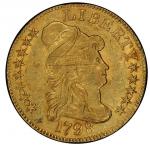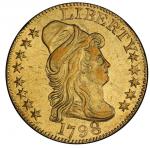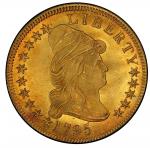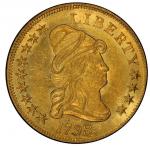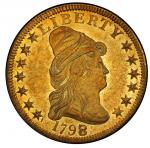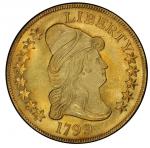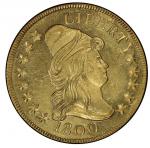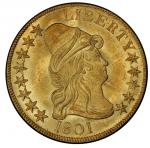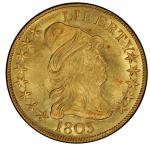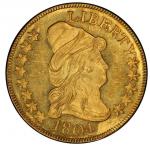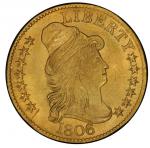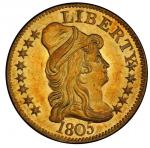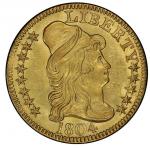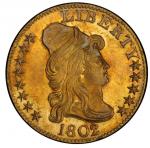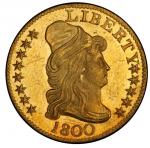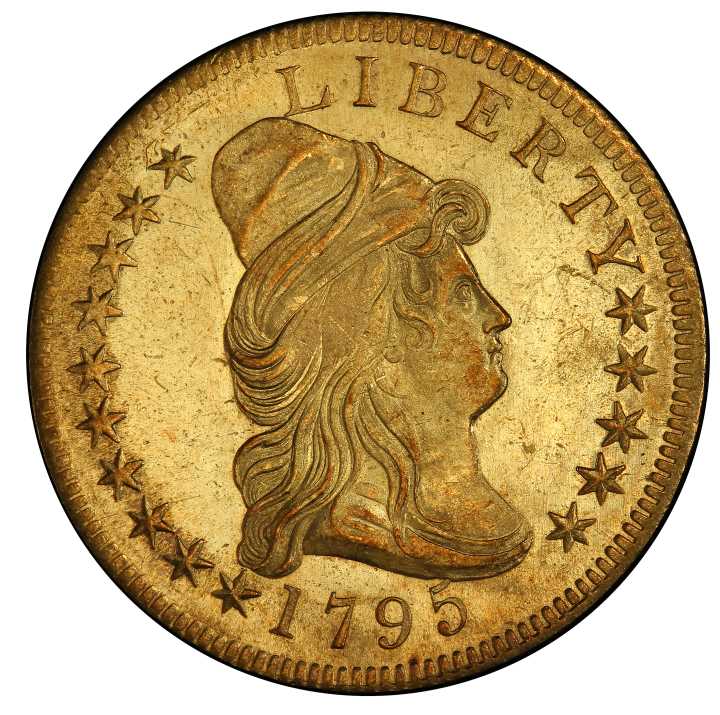This is by far the rarest variety of 1795 eagle and is far rarer than either the 1796 or 1797 Small Eagle coins. -- John Dannreuther.Perhaps the most famous rarity among the early eagles, the D. Brent Pogue 1795 9 Leaves eagle is in an unparalleled state of preservation, an appropriate starting point for the finest set of early eagles ever sold at auction. This is the single finest example certified by PCGS, potentially surpassed by only the Harry Bass Core Collection coin on display at the American Numismatic Association Museum. The brightly reflective surfaces show resounding cartwheel luster, bolder and more frosty on the obverse than the reverse. Light yellow gold dominates both sides, though some design elements show attractive copper tones on their highest relief. The obverse shows scattered fine marks and lines; while none are particularly notable, we mention a thin scratch and light abrasion, both under TY of LIBERTY. Some shallow planchet granularity is seen in the vicinity of the date. The reverse appears somewhat busier than the obverse due to similar granularity, noticeable under the wing at left, above and below the wing at right, and near the top of the wreath. Mostly obliterated adjustment marks are seen on the reverse, criss-crossing inside the wreath and under UNITED, but visible in some proportion over much of the surface area of that side. The devices remain well-defined, and the distinctive nine-leaved olive branch that has brought this rarity its fame is both intact and elegantly depicted. The die state is typical, with heavy reverse breaks manifesting as buckling at the tip of leaf 2, atop the first T in STATES, and at the first A in AMERICA. Lapping has hollowed spots near the wingtip at left, inside the wing at right, and at the upper juncture of the tail to the eagles leg. The obverse shows raised spalling between the date and star 1, and lapping has altered the outline of stars 1, 9, 10, 11, and 15.The broken state of the reverse, present on all known specimens, probably explains this varietys rarity. Most researchers agree that about 20 specimens are known, several of which are low grade. The variety was apparently discovered by William H. Woodin, a student of the early gold series, who recognized it as a great rarity. Waldo Newcomer gave the variety his imprimatur in 1926 by buying the Woodin specimen for $100, which Walter Breen suggested "was several times the then going price for 1795s in that grade." A second specimen was not identified until 1960, when Breen cataloged one for New Netherlands 55th sale, calling it "of extreme desirability as a type coin." Interest in the variety grew with the recognition of it as a major type (the only early eagle with 9 leaves on the reverse) and a major rarity, though as late as 1980 David Akers reported that "it has never received any publicity." Its profile is much higher in the present day. John Dannreuther writes in the Bass-Dannreuther book that "it is one of the most famous die varieties among all early gold coins -- the king of the Small Eagle type."Among the 11 records the PCGS Population Report reflects, undoubtedly representing fewer individual specimens, three examples of this major variety are listed in grades of MS-63 and higher. This coin, graded MS-63+, is the finest certified by either grading service (the sole MS-63 on the NGC Census is an old entry for this coin). The highest graded piece to ever sell at public auction was certified as MS-61 (PCGS), offered in a 2011 sale.Not every die variety is distinctive enough, or famous enough, to merit separate mention in places like A Guide Book of United States Coins. Such distinction comes with broad-based interest and demand, and no other early eagle variety enjoys such popularity as the 1795 9 Leaves. The D. Brent Pogue specimen is the finest example that remains in collectors hands, making it a potential crown jewel in any advanced collection of early United States eagles.


